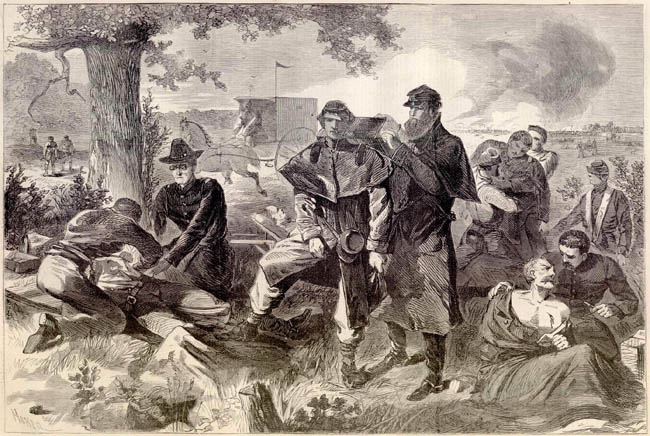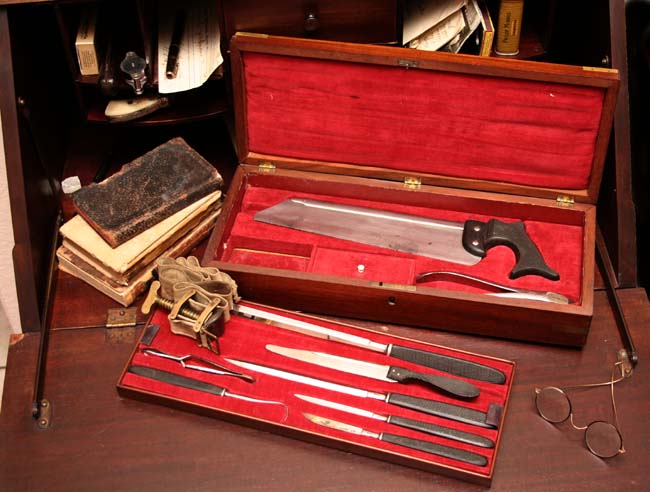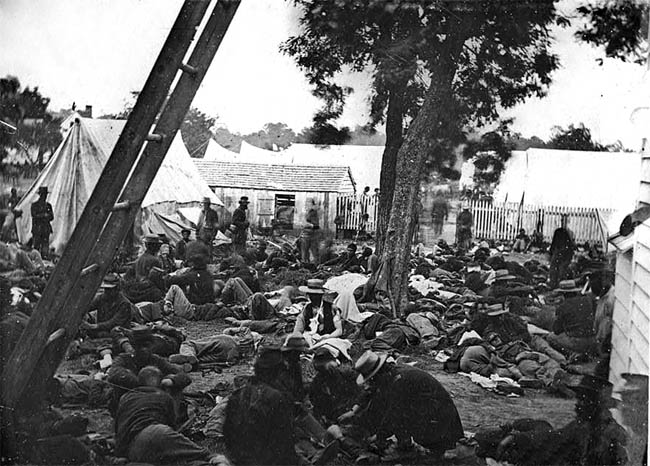|
Twice as many men died of disease
than of gunshot wounds in the Civil War. Dysentery, measles, small
pox, pneumonia, and malaria were the soldier's greatest enemy. The overall
poor hygiene in camp, the lack of adequate sanitation facilities, the cold
and lack of shelter and suitable clothing, the poor quality of food and
water, and the crowded condition of the camps made the typical camp a
literal breeding ground for disease. Conditions, and resulting disease, were
even worse for Civil War prisoners, who were held in the most miserable of
conditions.
In order to try and curb these
appalling conditions in camp, and the resulting rampant disease, the
Sanitary Commission was formed. The Sanitary Commission tried to
educate the army on proper sanitation techniques to help stem the spread of
disease. The
sanitary commission report issued in 1861 was widely disseminated, and
included many guidelines to improve sanitation and reduce disease.

Winslow Homer's
Famous 1862 Drawing of a
Civil War Surgeon at Work in the Field
While soldiers were at risk of
disease, they also faced great peril in battle. The Civil War was a
very bloody affair. More men were killed in the Civil War than in all
previous American Wars Combined! More men died at the Battle of
Antietam than any other day in American History. The casualties at
Antietam were twice the casualties suffered at D-Day. Part of the reason for
these horrific casualty statistics is that the Civil War was the first
American War in which Rifled barrels were extensively used. The rifled
barrel significantly increased the range at which you could accurately hit a
target. Despite this fact, the armies (the Union Army in particular)
continued to use Napoleonic battle tactics. These tactics would send
large forces of infantry against entrenched opponents. When an entrenched
opponent was armed with smoothbore muskets, these Napoleonic tactics could
work. The relative inaccuracy of the smoothbore muskets gave the
advancing infantry a fair shot at actually reaching the enemies' trenches,
and then engaging in hand-to-hand combat. The pinpoint accuracy of the
new rifled muskets, however, would allow the entrenched combatants to begin
to thin the ranks of the advancing infantry at a very great range, and
effectively decimate them before they could reach the entrenchments. The
failure of the commanders to realize this fact, combined with similar
advances in artillery, led to untold casualties and carnage in the
war.

Original Amputation Kit Used in the Civil
War
Amputation
The huge carnage that resulted
from these frontal attacks, combined with a relatively few number of poorly
equipped surgeons led to fairly dismal prospects for any soldier unlucky
enough to be shot or otherwise injured in battle. Those with serious
injuries in the torso would simply die. For those who were shot in an
extremity, the options were few, in fact, really one: amputation. There is
an interesting account of Battlefield medicine in the July 12, 1862 edition
of Harper's Weekly, which we present an excerpt below:
The
Surgeon At Work in the Field
The "Surgeon
at Work" introduces us to the most painful
scene on the battle-field. Away in the rear, under the
green flag, which is always respected among civilized
soldiers, the surgeon and his assistants receive the
poor wounded soldiers, and swiftly minister to their
needs. Arteries are tied, ligatures and tourniquets
applied, flesh wounds hastily dressed, broken limbs set,
and sometimes, where haste is essential, amputations
performed within sight and sound of the cannon. Of all
officers the surgeon is often the one who requires most
nerve and most courage. The swaying tide of battle
frequently makes him a prisoner, and sometimes brutal
soldiers will take a flying shot at him as they pass.
Upon his coolness and judgment depend the lives of a
large proportion of the wounded; and if they fall into
the enemy's hands, military rule requires that he should
accompany them as a prisoner. An arrangement has lately
been made between General Howell Cobb, of the rebel
army, and Colonel Keys, of the army of the Potomac, by
which surgeons are to be considered non-combatants and
released from custody as soon as their wounded are in
the hands of the surgeons of the enemy.
|
During major engagements the
flood of wounded became simply overwhelming. The surgeon could afford
to spend precious few minutes with each of the injured. This led to
amputation being the treatment of choice for injuries to an appendage.
Chloroform was used during the Civil War, when it was available. Use
of Chloroform as an anesthetic greatly reduced the torture and trauma of the
procedure. The Chloroform was applied to a cloth and held over the soldier's
nose and mouth until the man was unconscious.
Due
to the enormous number of wounded, the Civil War Surgeons became proficient
at performing amputations. In many cases the amputation would be
performed in 10 minutes. Surgeons, along with their assistants, would work
round the clock, ending up with stacks of amputated limbs up to five feet
high. The number of wounded needing attention, and the relative lack
of water meant that there was no attempt to wash hands or instruments
between procedures. This lack of hygiene and sterility did create a large
chance of infection. However, it has been estimated that as many as
75% of the amputees did recover.

This photograph
of the field hospital at the Battle of Savage Station gives the reader a
better view of the conditions of Civil War medicine than can be described in
words. Notice that the wounded do not have the benefit of shelter, and are
left to suffer in the sun. The number of wounded far exceeds the
number available to help with treatment. The injured are doubtlessly
suffering not only from their wounds and lack of care, but also from the
elements.
The Practice of Surgery:
Amputation
 Many Civil War
surgeons would have learned the art of amputation from the book "The
Practice of Surgery", by Samuel Cooper, with Notes by Dr. Alexander H.
Stephens. I have a copy of this book used by an actual Civil War
Surgeon, Colonel Dr. Peter C. Woods of the Confederate States Army.
The book is filled with fascinating details of the state of "Medicine" at
the time of the Civil War. It is somewhat frightening to read the relative
immaturity of the medical profession at this time. Of particular
interest to the student of the Civil War is the section on
Amputation, which I have transcribed for your
perusal. Look here for "The Practice of Surgery:
Amputation" Many Civil War
surgeons would have learned the art of amputation from the book "The
Practice of Surgery", by Samuel Cooper, with Notes by Dr. Alexander H.
Stephens. I have a copy of this book used by an actual Civil War
Surgeon, Colonel Dr. Peter C. Woods of the Confederate States Army.
The book is filled with fascinating details of the state of "Medicine" at
the time of the Civil War. It is somewhat frightening to read the relative
immaturity of the medical profession at this time. Of particular
interest to the student of the Civil War is the section on
Amputation, which I have transcribed for your
perusal. Look here for "The Practice of Surgery:
Amputation"
|



 Many Civil War
surgeons would have learned the art of amputation from the book "The
Practice of Surgery", by Samuel Cooper, with Notes by Dr. Alexander H.
Stephens. I have a copy of this book used by an actual Civil War
Surgeon, Colonel Dr. Peter C. Woods of the Confederate States Army.
The book is filled with fascinating details of the state of "Medicine" at
the time of the Civil War. It is somewhat frightening to read the relative
immaturity of the medical profession at this time. Of particular
interest to the student of the Civil War is the section on
Many Civil War
surgeons would have learned the art of amputation from the book "The
Practice of Surgery", by Samuel Cooper, with Notes by Dr. Alexander H.
Stephens. I have a copy of this book used by an actual Civil War
Surgeon, Colonel Dr. Peter C. Woods of the Confederate States Army.
The book is filled with fascinating details of the state of "Medicine" at
the time of the Civil War. It is somewhat frightening to read the relative
immaturity of the medical profession at this time. Of particular
interest to the student of the Civil War is the section on